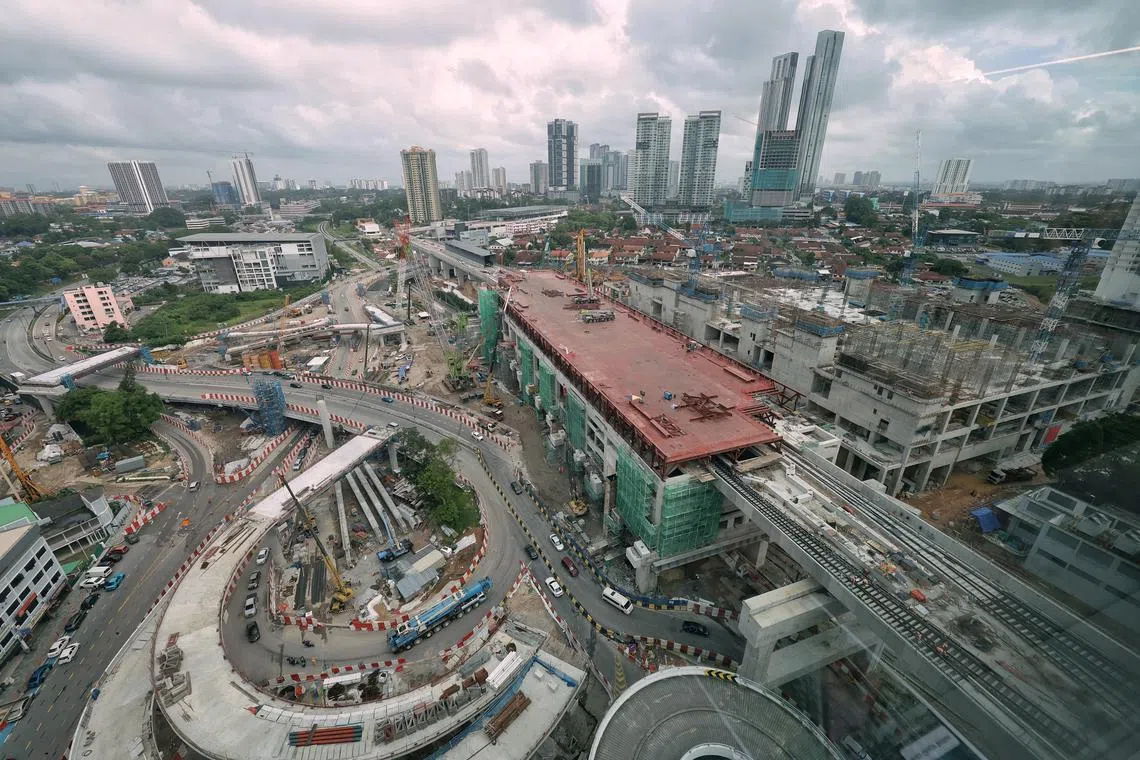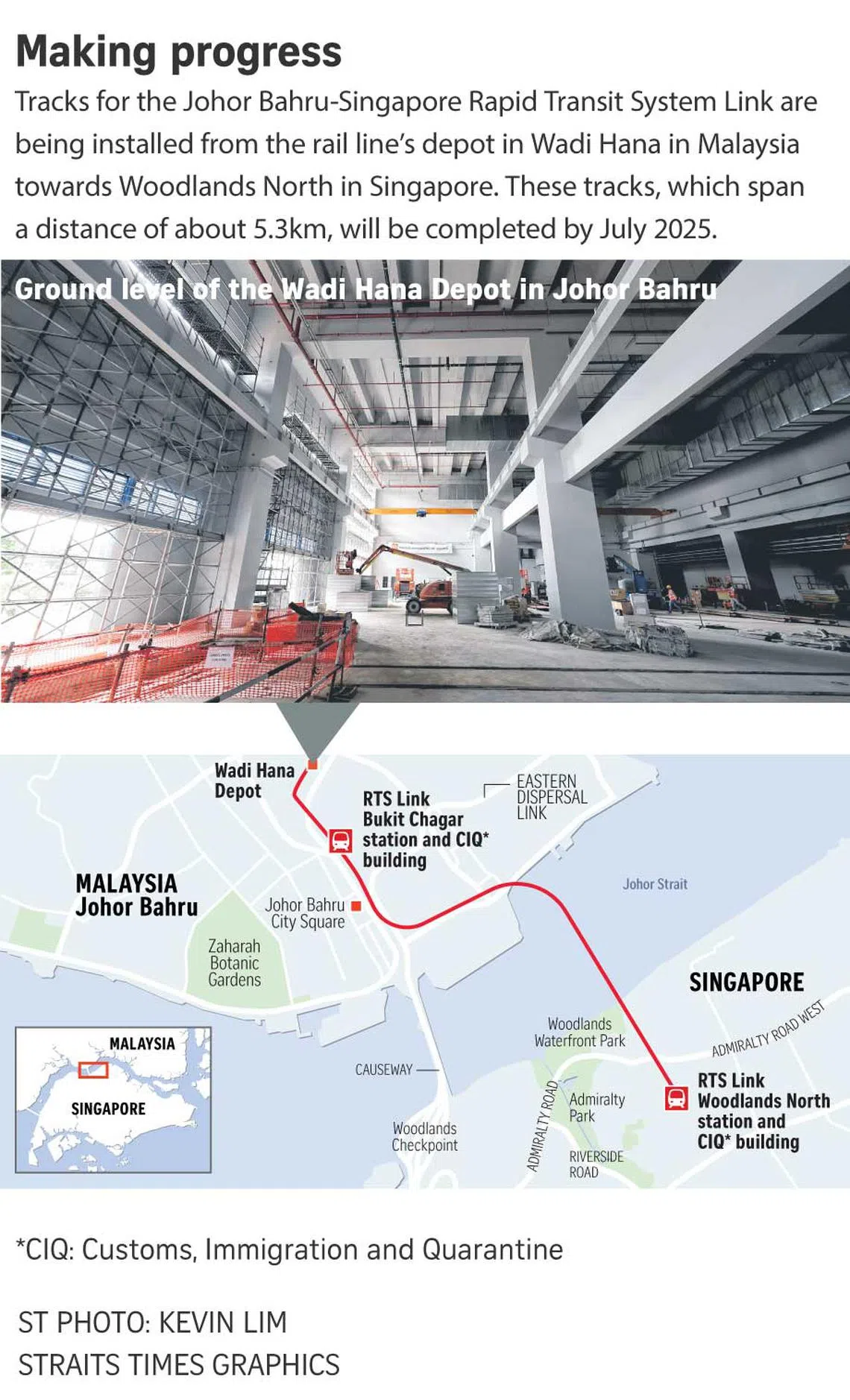JB-S’pore RTS Link systems 50% complete; tracks from Malaysia to Woodlands to be done by July
Sign up now: Get ST's newsletters delivered to your inbox

Tracks are also being installed on the viaducts around Bukit Chagar station (with red roof), the Malaysian terminus of the RTS rail link.
ST PHOTO: KEVIN LIM
Follow topic:
JOHOR BAHRU – Work to get the rail systems of the Johor Bahru-Singapore Rapid Transit System (RTS) Link up and running has reached the halfway mark, as the cross-border rail project moves closer to completion.
Since September 2024, RTS Operations (RTSO),
Tracks are also being installed on the viaducts around Bukit Chagar station – the Malaysian terminus of the two-station, 4km rail link.
RTSO said on Feb 26 that the trackwork will extend towards Woodlands North station in Singapore and be completed by July.
Other system works will be done in phases, added RTSO, a Singapore-incorporated joint venture between Singapore rail operator SMRT and Malaysian public transport firm Prasarana.
For instance, the installation of the traction power, signalling and communications systems for the RTS Link will start from March. Traction power refers to the electricity that powers trains.
At a media briefing held at the company’s new corporate office in the Johor Bahru city centre, RTSO project director Zahrin Abdul Gani said the rail system works, which include testing and integration, are expected to peak over the coming months and hit a “crescendo” around the third quarter of 2026.
After that, trial operations will be carried out, with the aim of starting passenger service by the end of 2026, as scheduled.
RTSO chief executive Ahmad Marzuki Ariffin said: “Our goal is to deliver a reliable transport service that alleviates congestion and strengthens cross-border connectivity.”
Dr Marzuki was asked at the briefing when the fares for the new rail service will be announced, and if the fare will be the same in Malaysian ringgit and Singapore dollars.
In response, he referred reporters to an earlier statement by Malaysian Transport Minister Anthony Loke, who said ticket prices would be made known closer to the start of passenger service in 2026.
Dr Marzuki added in Malay: “There are actually a lot of processes to determine the fare, seeing as it involves two countries.”
When ready, the RTS Link will be able to carry up to 10,000 people an hour in each direction, with RTSO promising a train frequency of 3.6 minutes during peak hours.
The line will be served by eight train sets manufactured by Chinese train maker CRRC Zhuzhou Locomotive.
The first of these four-car trains has already been assembled and tested at the factory in Zhuzhou in China’s Hunan province.
Asked when these trains will be delivered, Mr Zahrin said: “What we can report at this stage is that we are making good progress.”
Under a bilateral agreement signed in 2020,
Meanwhile, RTSO will own, design, build and finance the rail link’s operating assets, such as the tracks and various core systems.
As at Feb 26, the RTS Link viaducts on the Malaysia side have been completed.
Works to fit out Wadi Hana depot, as well as the station and immigration complex in Bukit Chagar, are under way.
On the Singapore side, more than 80 per cent of the civil infrastructural works have been completed. The remaining works include architectural works, roadworks and the installation of non-rail systems such as immigration gates.
Since November 2024, RTSO has been progressively given access to the RTS Link’s civil structures, so it can begin installing the rail systems.

On Feb 26, Singapore and Malaysian media were taken on a visit to Wadi Hana depot for the first time to get an idea of how the rail link’s tracks are being installed.
The depot sits on a 5.7ha plot of land about 1km north of Johor Bahru Sentral.
The top floor of the depot, which is about 15m above ground, will have seven tracks in all. There are separate tracks for light and heavy maintenance, two tracks used to store trains, and another track that leads to an automatic train washing area.
In all, about 1.3km of tracks will need to be installed at the depot, 7.7km on the viaducts, and 3.1km in the underground tunnels on the Singapore side.
The installation process first entails welding together steel rail pieces about 25m in length, to form longer 250m segments. These segments are then laid atop concrete sleepers and secured using rail fasteners.
Next, the spaces between the sleepers are filled with concrete and other parts of the track, such as the third rail, which supplies power to the trains, are installed.
The joints between each 250m-long rail segment also need to be welded together, using a method that involves generating temperatures of more than 2,500 deg C. According to RTSO, 690 of such welds are needed for the entire RTS Link project.
Given the rail line’s proximity to saltwater, which can cause metal to corrode, a number of the components have been designed to better withstand such conditions.
For instance, the brackets that support the RTS Link’s third rail are made of a glass-reinforced polymer, similar to fibreglass, instead of the usual steel.
A representative from China Harbour Engineering Company, the contractor in charge of the RTS Link’s trackwork, said this is the first time such support brackets are being used on a rail system in Singapore and Malaysia.
RTSO said there are about 150 workers carrying out the installation of the RTS Link tracks and systems today. When passenger service starts by the end of 2026, the rail line will be staffed by about 200 operations and maintenance workers.
Kok Yufeng is a transport correspondent at The Straits Times.


